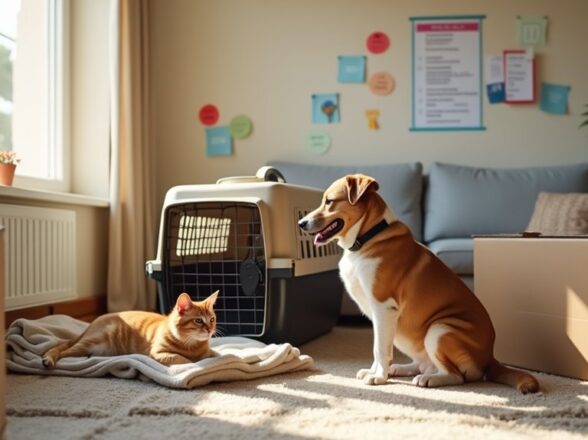What Are the Best Practices for Long-Term Pet Boarding? How to Ensure Your Pet’s Safety and Comfort

To guarantee your pet's safety and comfort during long-term boarding, start by selecting a reputable facility with positive reviews and qualified staff. Visit the facility to assess cleanliness and security. Prepare your pet by gradually introducing them to the environment and packing familiar items for comfort. Provide essential documentation like vaccination records and emergency contacts. Communicate your pet's needs clearly to the staff. Monitor your pet for any stress signs during their stay and upon return. Establish routines for feeding and exercise to help with adjustment. There's more to reflect on for a smooth boarding experience.
Choosing the Right Facility
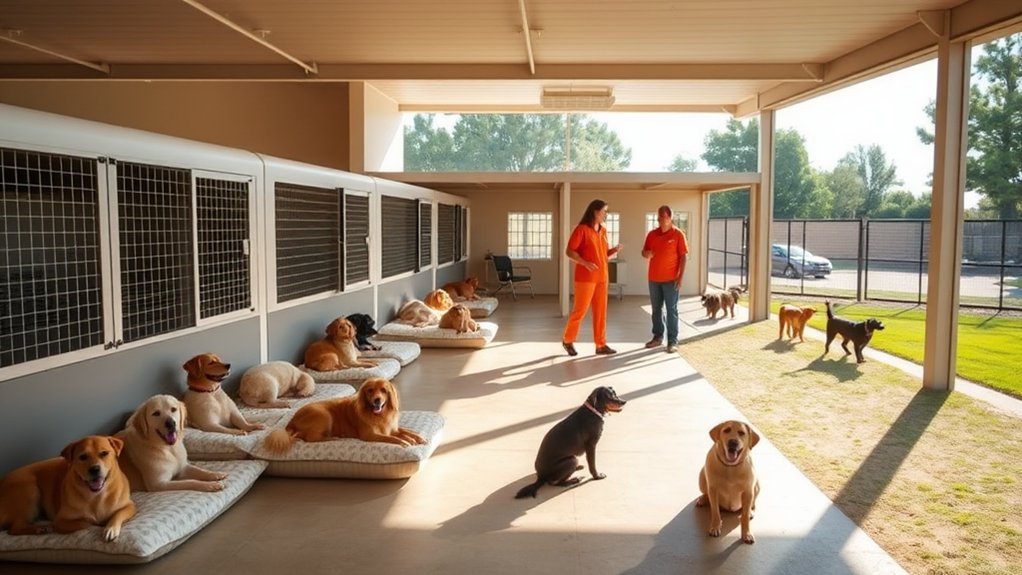
How can you guarantee your pet's comfort and safety while you're away? Start by choosing the right facility. Look for places with positive reviews and a solid track record in long-term dog boarding. Visit potential facilities to check their cleanliness and safety measures, like secure fencing and effective health protocols. Inquire about staff qualifications, their experience, and the staff-to-dog ratios. This assures your pet gets individualized attention. Confirm that they require up-to-date vaccinations to maintain a healthy environment. Evaluate the amenities available, such as separate play areas for different dog sizes. Structured daily routines are essential for promoting safety and well-being during your pet's stay. Make informed decisions to keep your pet safe and comfortable.
Preparing Your Pet
Preparing your pet for boarding involves a few key steps to guarantee a smooth changeover. Start by gradually introducing them to the facility through short visits, which can help reduce anxiety. Also, pack familiar items like their favorite blanket or toys to make them feel more at home during their stay.
Gradual Familiarization Techniques
As you get ready for your pet's long-term boarding stay, gradually familiarizing them with the new environment can make a significant difference in their comfort level. Start with short visits or trial stays to help your pet acclimate to the environment and staff. Use positive reinforcement techniques, like treats and praise, to create positive associations during these visits. Familiarizing your pet with crates at home can also increase their comfort level if the facility uses them. Maintain a calm and relaxed demeanor during visits to reduce anxiety. Finally, practice gradual departures from home, beginning with brief absences, to help your pet adjust to the idea of separation before their long-term stay.
Essential Packing Checklist
When getting ready for your pet's long-term boarding stay, having a well-thought-out packing checklist is essential. This guarantees your pet's comfort and safety during their time away from home.
| Item | Purpose |
|---|---|
| Regular food | Maintains diet consistency |
| Familiar items | Provides anxiety reduction |
| Medications | Meets health needs |
| Identification tags | Guarantees safety and easy identification |
| Vaccination records | Complies with health documentation requirements |
Don't forget to include clear feeding instructions to avoid digestive issues and pack any necessary health documentation. This preparation helps guarantee your pet feels secure and well-cared for while you're apart.
Essential Documentation
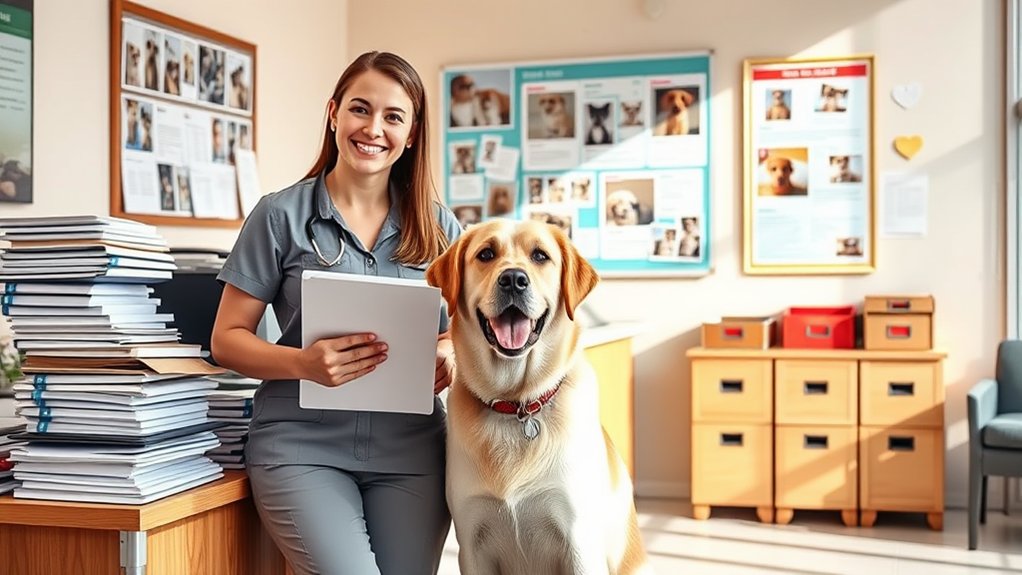
Having the right documentation is vital for a smooth boarding experience for your pet. Most boarding facilities require proof of vaccinations, including rabies, DHPP, and Bordetella. Make sure your dog has up-to-date vaccination records to meet these vaccination requirements. You should also prepare a municipality registration and a pet passport, as these might be necessary in certain areas. A recent deworming certification is essential for health and safety, guaranteeing your dog is free from parasites. Additionally, provide documentation of flea and tick prevention to protect your pet and others. Finally, supply emergency contact information with multiple reachable numbers for prompt communication in case of urgent situations. This documentation helps guarantee your pet's safety and well-being during their stay.
Communication With Staff
When boarding your pet, clear communication with the staff is essential. Share detailed information about your pet's personality and preferences so they can provide tailored care. Additionally, request regular updates to stay informed about your pet's well-being during their stay.
Share Detailed Information
Effective communication with the boarding staff is essential for guaranteeing your dog's comfort and safety. You should share detailed information about your pet's needs. This includes:
| Detail | Information | Importance |
|---|---|---|
| Feeding Schedule | Specify times and amounts | Guarantees proper nutrition |
| Dietary Restrictions | Note allergies or special diets | Prevents health issues |
| Emergency Contacts | Provide your info and a backup | Enables quick decisions |
| Recent Changes | Mention behavior or health issues | Prepares staff for care |
Request Regular Updates
How can you guarantee peace of mind while your pet is boarding? One effective way is to request regular updates from the facility. Some boarding services provide daily updates, while others may offer them upon request. Establish clear communication with the facility staff by discussing your preferred methods for receiving updates, such as text messages, emails, or photos. Inquire about the frequency and type of updates you can expect regarding your pet's behavior, health, and interactions. Make sure to provide detailed information about your pet's needs to receive tailored updates. Also, establish emergency contact information so the facility can reach you in urgent situations. This proactive approach enhances your pet's safety and comfort during their stay.
Gradual Transition Techniques
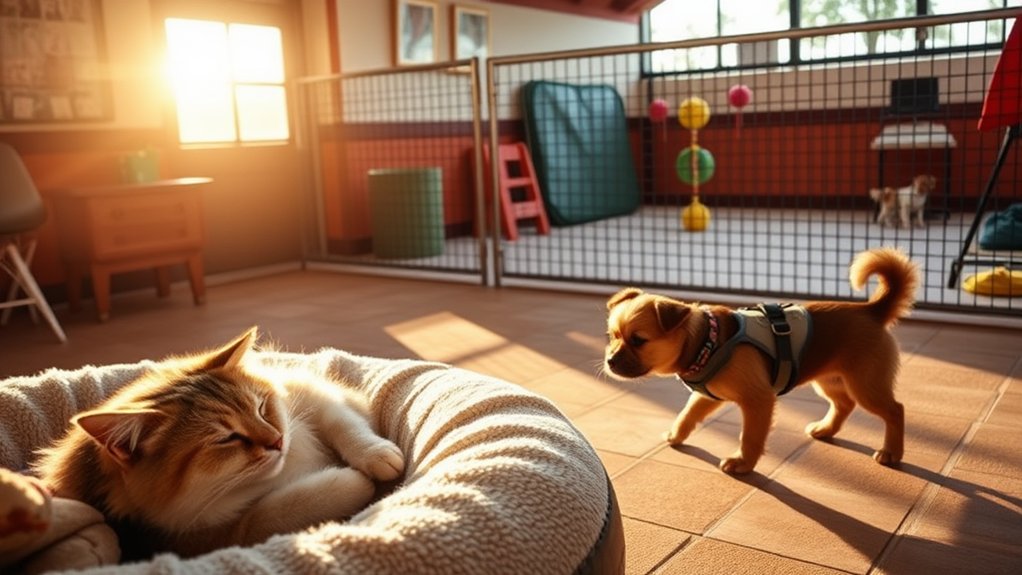
To ease your dog into a boarding facility, it's essential to implement gradual adaptation techniques that help reduce anxiety and create a positive experience. Start by scheduling short visits or trial stays to help your dog acclimate to the new environment. Use positive reinforcement, like treats and praise, during these visits to build favorable associations with the facility and staff. Allow your dog to explore different areas and interact with staff members before their long-term stay. Practice departure training by leaving your dog alone for short periods, gradually increasing the duration. Bringing comfort items from home, such as favorite toys or bedding, provides a sense of security and familiarity during this adaptation.
Managing Separation Anxiety
While managing separation anxiety in dogs can be challenging, recognizing the signs early can lead to effective solutions. Look for signs of stress like excessive barking or reluctance to eat. Implement gradual departure training by starting with short absences, gradually increasing the time apart. When leaving your dog at a boarding facility, create low-key departures to minimize emotional fuss. Provide a safe space filled with familiar items to help your pet feel secure. Establish consistent daily routines for feeding, exercise, and playtime to reinforce a comforting atmosphere. These strategies can greatly reduce anxiety and help your dog adapt better during times of separation, ensuring a smoother experience for both you and your pet.
Ensuring Comfort and Enrichment
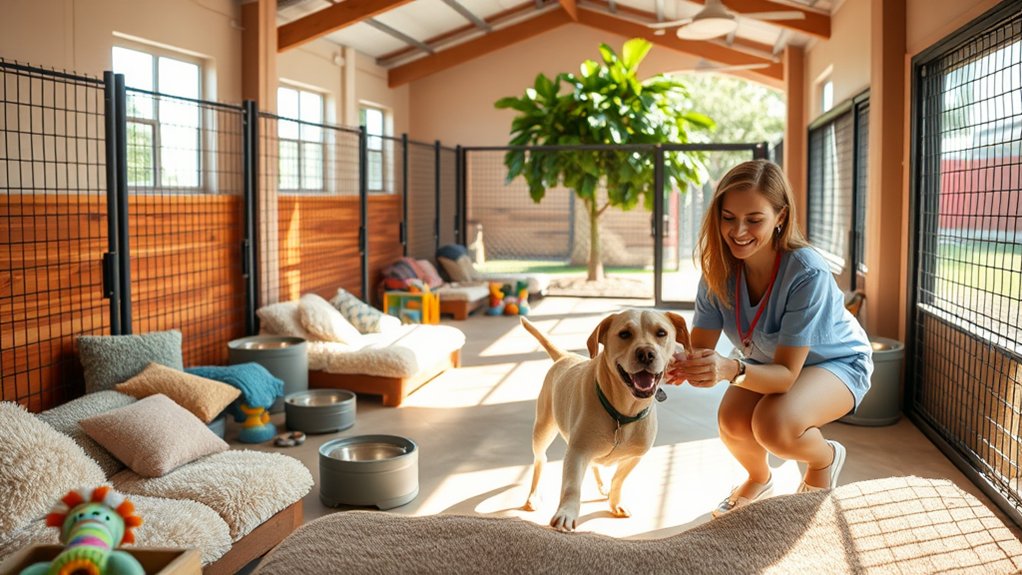
Guaranteeing your pet's comfort and enrichment during boarding is essential for their well-being and happiness. Start by designating a secure area with familiar items like your pet's favorite bedding and toys. This helps reduce anxiety and creates a sense of safety. The boarding facility should provide structured daily routines that include playtime, exercise, and rest periods. Access to enrichment activities, such as puzzle toys and interactive games, keeps your pet mentally stimulated. Additionally, calming elements like soothing music can help alleviate stress. Ascertain that the facility has separate play areas for dogs of different sizes and temperaments. This promotes safe interactions, enhancing comfort and social skills among pets while they enjoy their stay.
Post-Boarding Care
Once your pet returns home from a long-term boarding stay, it's crucial to watch for any signs of stress or anxiety. For at least a week, monitor your pet for behavior changes, eating habits, or sleeping patterns. Here are some tips for effective post-boarding care:
- Schedule a follow-up vet visit within a week to check for any health issues that may have arisen during boarding.
- Gradually reintroduce training routines and normal schedules, including feeding, walks, and playtime, to help ease the adjustment.
- Provide extra affection and attention during this period to reassure your pet and alleviate anxiety from their boarding experience.
Keep a record of behavior changes and communicate concerns with your veterinarian or boarding facility as needed.
Monitoring Health and Behavior
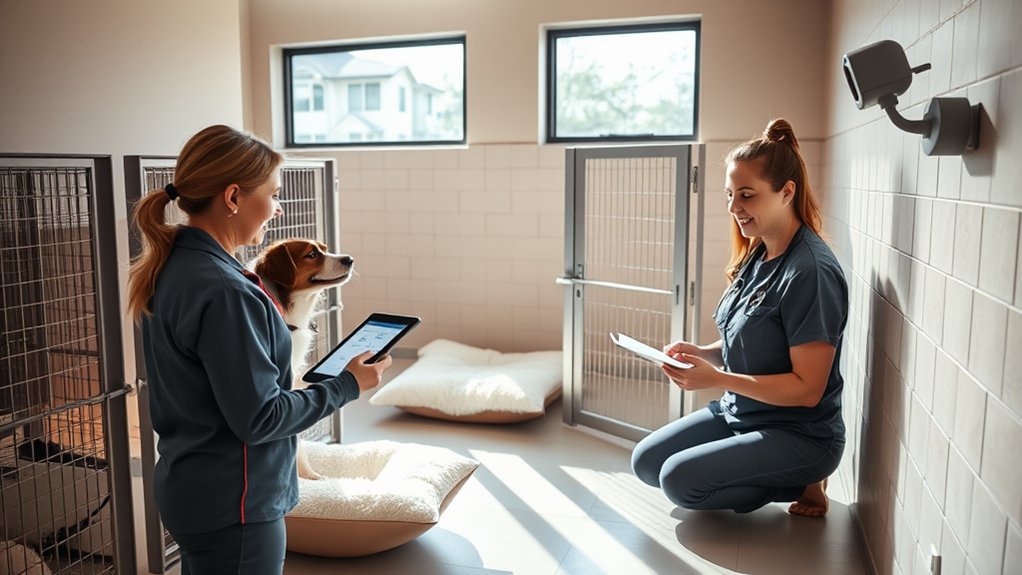
After your pet has settled back in, keeping a close eye on their health and behavior becomes important. Start by monitoring health closely for any signs of illness or distress. Inform the boarding facility about any pre-existing health conditions or behavioral concerns, so they can provide tailored care during the stay. Request regular updates on health, which helps you stay informed. Verify the facility conducts daily checks to catch any issues early and has immediate access to veterinary care if necessary. When you bring your pet home, observe any changes in behavior or physical condition. Maintain a record of health issues or behavioral changes noted by staff, which can guide future boarding decisions and care plans.
Frequently Asked Questions
How Do I Keep My Pet Healthy and Safe?
To keep your pet healthy and safe, guarantee proper nutrition, regular exercise, and up-to-date vaccinations. Monitor hydration, provide socialization opportunities, and reduce stress with mental stimulation. Always maintain health checkups and know the emergency protocols.
How Do I Prepare My Dog for Boarding?
To prepare your dog for boarding, create a boarding checklist including health records, comfort items, and feeding routine. Focus on training, socialization skills, and adjustment tips to ease stress and guarantee a smooth experience.
Do Dogs Feel Abandoned When Boarded?
Yes, dogs can feel abandoned when boarded, often showing dog separation anxiety. The boarding facility environment impacts their emotional response. Familiar scent comfort and gradual acclimatization help ease behavioral changes during this adjustment period.
How Do You Maintain Hygiene With Pets?
Maintaining hygiene with pets is like nurturing a garden; you've got to keep things clean. Regular cleaning, proper waste disposal, and safe cleaning supplies guarantee a safe environment, while grooming and vaccination records help with allergy management.
Conclusion
Choosing the right boarding facility is like selecting a safe harbor for your ship. By preparing your pet, guaranteeing proper documentation, and maintaining clear communication with staff, you can navigate this journey smoothly. Gradual shifts and thoughtful care during their stay will ease any anxiety. After returning home, monitor their health and behavior closely. With these best practices, you can guarantee your pet's comfort and safety, making their boarding experience as pleasant as possible.
Related posts
Recent posts
Post Categories
Tags
Subscribe

